Press
SoMAS News from Stony Brook University and other sources
$2.1 Million Awarded for Sea Grant Research on NY’s Coastal Environment
From $2.1 Million Awarded for Sea Grant Research on NY’s Coastal Environment on Stony Brook University News, October 16, 2020.
New York Sea Grant (NYSG) has awarded more than $2.1 million to support six coastal science research projects —three of which are being led by Stony Brook University faculty — that explore topics relating to and benefiting New York’s coastal environment, communities and economies. The projects are sponsored by NYSG and funded through the National Oceanic and Atmospheric Administration (NOAA), Sea Grant’s federal parent agency.
“New York Sea Grant is excited to announce six new projects selected through our biennial call for research proposals,” said NYSG Director Dr. Becky Shuford. “After a thorough peer review process followed by a technical review panel, projects were selected that address a variety of research topics and cover the diverse geography of our State as well as multiple subjects of interest to our stakeholders.”
“This set of projects — addressing topics such as coastal processes and community flood resilience, microplastic impacts on benthic organisms and environments, aquaculture studies to support understanding of the potential of shellfish and macroalgae operations, and habitat restoration — will contribute to the long-standing and growing body of NYSG-supported science-based knowledge available to coastal communities in New York State.”
Project Summaries
Identification of Superior Diploid and Triploid Oyster Lines for Aquaculture Operations in New York
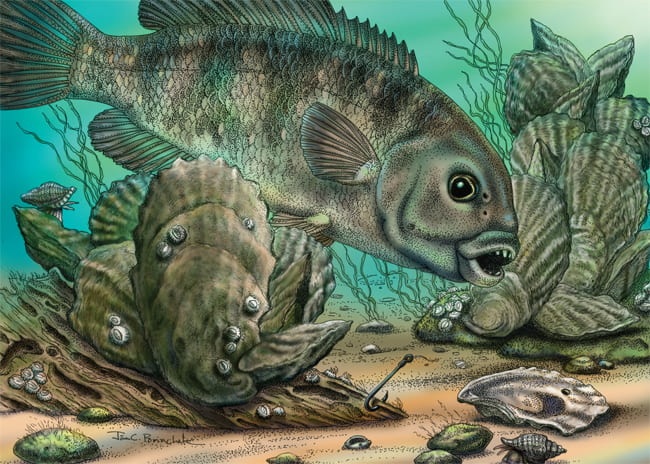
Oyster reefs were once a dominant feature of estuaries along the Atlantic and Gulf of Mexico coasts with healthy communities of eastern oyster. New research supported by NY Sea Grant will provide information to support oyster restoration efforts in NY/NJ harbor. Image credit: Jan Porinchak
Oyster aquaculture represents a sustainable industry that contributes to the economies of local coastal communities. Marinetics Endowed Professor Bassem Allam, from Stony Brook’s School of Marine and Atmospheric Sciences (SoMAS), is leading a team including Research Associate Professor Emmanuelle Pales-Espinosa and Professor Robert Cerrato, also of SoMAS, and Cornell Cooperative Extension’s Gregg Rivara in a study comparing the performance of different oyster lines derived from different genetic backgrounds. Further, the team will contrast the performance of locally derived triploid oysters with that of their diploid counterparts. Superior oyster lines identified during the study will be maintained and broadly distributed to the aquaculture industry in the state and beyond. New York consumers will benefit from an increased availability of high quality and competitively priced oyster products.
Erosion and Recession of Coastal Bluffs: Characterizing Erodibility of Bluff Materials under Various Land- and Sea-Based Conditions
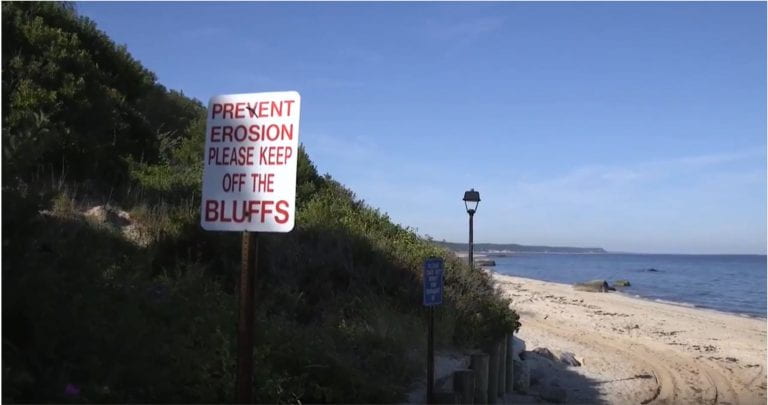
In an effort to help prevent erosion, signage encourages beachgoers to keep off coastal bluffs. New research supported by NY Sea Grant will provide information that will allow for improved prediction of bluff erosion that informs planning by coastal communities.
Image credit: Cornell Cooperative Extension Marine Program
Coastal bluffs comprise a significant percentage of shorelines in the Great Lakes, U.S. Atlantic and Pacific Coasts. Erosion and recession of bluffs are an issue of concern to coastal communities and are being more frequently and extensively impacted by rising sea levels, extended droughts, heavier rainfall, and coastal storms. Assistant Professor Ali Farhadzadeh, from Stony Brook’s Department of Civil Engineering and also SoMAS, and Distinguished Service Professor Henry Bokuniewicz of SoMAS will conduct a study to identify and quantify some of the underlying processes, both sea- and land-based that lead to coastal bluff erosion. With an enhanced understanding of the factors involved with bluff recession gained through this project, a modeling framework that improves prediction of bluff erosion is expected. The developed model could also be used to identify risk areas where shoreline protection measures, including natural and nature-based features, could prevent or slow further recession. The results will be useful for resource managers and property owners to better predict and respond to future erosion under varying climate changes.
The Use of Macroalgae to Expand Aquaculture and Prevent, Control, and Mitigate Harmful Algal Blooms in New York’s Coastal Zones
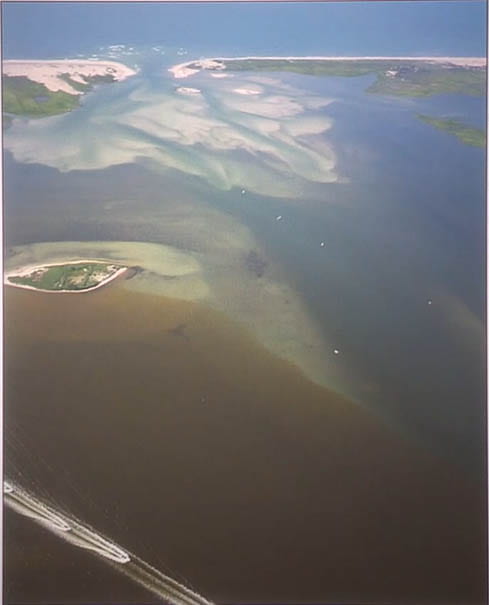
Long Island’s Great South Bay became clearer during the 2019 season due to a new inlet but it is not immune to brown tides and other harmful algal blooms (HABs). New research supported by NY Sea Grant will develop and test shellfish aquaculture techniques that integrate macroalgae culture. Macroalgae have been shown to help control a variety of HABs populations.
Image credit: Chris Gobler
During the past several decades, harmful algal blooms (HABs) have had significant environmental and economic consequences in New York’s coastal waters. Endowed Chair of Coastal Ecology and Conservation Christopher Gobler and Senior Research Support Specialist Michael Doall of SoMAS will conduct a study to assess the ability of cultivable macroalgae to inhibit the growth of HAB species common to NY waters while also expanding potential aquaculture opportunities. Previous studies have shown that macroalgae can inhibit the growth of HAB species through several mechanisms, including pH elevation, competition for nutrients, algicidal bacteria associated with macroalgae that produce allelochemicals that inhibit HABs species. The study will develop and assess cultivation techniques and test the feasibility of co-culturing HAB-combative seaweeds with bivalve shellfish at commercially viable scales on shellfish farms. The expected results of this project are the development of seaweed cultivation best practices and guidance materials that can be used by aquaculture operators and will create an opportunity to both expand the scope of the New York aquaculture industry and introduce a cost-effective method for mitigating HABs.
The other three projects in NYSG’s most recent research suite, which are led by principal investigators at Cornell University and the Rochester Institute of Technology, focus on the Hudson River and Lake Ontario and spotlight issues including oyster restoration, flood resilience and marine debris. For more, read the press release.
This announcement will be featured in NYSG’s forthcoming newsletter, NY Coastlines, for which e-subscriptions can be made at seagrant.sunysb.edu/nycoastlines. The issue will also feature: A follow-up on products produced and projects undertaken this past summer to support NY’s coastal stakeholders during the COVID-19 pandemic; how Long Island’s bays fared this summer in regard to harmful algal blooms; recordings from NYSG’s virtual summer research seminar series and much more.
About New York Sea Grant
New York Sea Grant, a cooperative program of Cornell University and the State University of New York, is one of 34 university-based programs under the National Oceanic and Atmospheric Administration’s National Sea Grant College Program.
Since 1971, NYSG has represented a statewide network of integrated research, education and extension services promoting coastal community economic vitality, environmental sustainability and citizen awareness and understanding about the State’s marine and Great Lakes resources. Through NYSG’s efforts, the combined talents of university scientists and extension specialists help develop and transfer science-based information to many coastal user groups — businesses and industries, federal, state and local government decision-makers and agency managers, educators, the media and the interested public.
The program maintains Great Lakes offices at Cornell University, University at Buffalo, SUNY Oswego and the Wayne County Cooperative Extension office in Newark. In the State’s marine waters, NYSG has offices at Stony Brook University, Brooklyn College and Cornell Cooperative Extension’s NYC and Kingston locations. For more, visit nyseagrant.org.
Stephen Schwartz Receives International Aerosol Fellow Award
From Stephen Schwartz Receives International Aerosol Fellow Award by Joe Gettler in the Brookhaven National Lab Newsroom, November 4, 2020.
Stephen Schwartz, a senior scientist emeritus at the U.S. Department of Energy’s (DOE) Brookhaven National Laboratory and adjunct professor at the School of Marine and Atmospheric Sciences at Stony Brook University, has received the International Aerosol Research Assembly‘s (IARA) 2020 International Aerosol Fellow Award. This prestigious award recognizes outstanding contributions to aerosol science and technology through research, technical development, education, and service.
The aerosols Schwartz has studied for decades are tiny particles in Earth’s atmosphere. They are essential in the formation of clouds and create climate-cooling effects, because they reflect energy that “pours down” from the sun back out to space. Some aerosols occur naturally, for example, haze and particles from sea spray and forest fires. Others are created from human activities, importantly from emissions created by the combustion of fossil fuels.
Understanding more about aerosols and the processes they affect is helping scientists determine the extent human activity has increased aerosol levels in the atmosphere. Scientists’ findings are also them helping recognize aerosols’ specific roles in the global energy budget—the total amounts of energy entering and exiting Earth and its atmosphere—and impacts on global and regional climates.
Aerosol research has other important applications such as determining how air pollution impairs human health and how diseases like COVID-19 spread. Aerosol research has also helped improve industrial processes and national security.
“The motivations of aerosol research have evolved in my four decades as a scientist, from air quality to acid rain to climate change,” Schwartz said. “I am most grateful to Brookhaven National Laboratory and DOE for their continued support over the years, and to IARA for this award.”
When selecting him for the award, the IARA’s committee recognized Schwartz for high-profile, highly cited papers on atmospheric aerosols, cloud chemistry, and their impact on Earth’s radiation budget and climate. The committee noted Schwartz’s lead role on the team that established DOE’s Atmospheric Radiation Measurement Research Facility. The citation recognized his leadership in national and international measurement campaigns. It also cited Schwartz as a fellow of the American Geophysical Union, fellow of the American Association for the Advancement of Science, and key contributor to many national and international committees on aerosols and climate.
The IARA’s International Aerosol Fellow Award is given every two years to one or two honorees. Yoshio Otani, vice president for international affairs and professor at Kanazawa University in Japan, was also named a 2020 awardee.
Schwartz, a resident of Center Moriches, joined Brookhaven Lab in 1975. He rose through the ranks to senior scientist, and is now a senior scientist emeritus in the Lab’s Environmental & Climate Sciences Department. Schwartz is also an adjunct professor for Stony Brook University’s School of Marine and Atmospheric Sciences.
Schwartz has authored or coauthored over 140 journal articles and book chapters, 300 proceedings and abstracts, and more than 40 reports and reviews. He coauthored the book, “Sea Salt Aerosol Production: Mechanisms, Methods, Measurements and Models,” with fellow Brookhaven scientist Ernie Lewis, and edited two other books.
He served as chief scientist of DOE’s Atmospheric Science Program from 2004 to 2009 and was presented with DOE’s Outstanding Leadership Award in 2010.
Before joining Brookhaven, Schwartz earned a bachelor’s degree in chemistry from Harvard College in 1963 and a Ph.D. in physical chemistry from the University of California, Berkeley, in 1968. He was a Fulbright postdoctoral fellow and Ramsay memorial fellow at the University of Cambridge in England from 1968 to 1969. He also served on the faculty of the Chemistry Department at Stony Brook University from 1969 to 1975.
Brookhaven National Laboratory is supported by the U.S. Department of Energy’s Office of Science. The Office of Science is the single largest supporter of basic research in the physical sciences in the United States and is working to address some of the most pressing challenges of our time. For more information, visit https://energy.gov/science.
Follow @BrookhavenLab on Twitter or find us on Facebook.
# # #
Contact: Peter Genzer, (631) 344-3174
Eight Years after Sandy, Little Has Been Done to Prevent a Repeat Tragedy
Trump’s Advice: “Sorry, you’ll just have to get your mops & buckets ready!”
This Thursday, October 29, marks the 8th anniversary of Hurricane Sandy’s devastating flooding that killed 96 residents of the New York – New Jersey Metropolitan region, caused more than $70 billion in damage to homes and businesses, and disrupted hospitals, sewage treatment plants, airports, seaports, subways, tunnels and other critical infrastructure for weeks, months and in some cases years. The greatest devastation occurred in the most vulnerable working class, Black and Latino communities across the region.
New York City and their counterparts across the region have failed to develop or implement an effective plan to prevent a recurrence of this disaster, even though climate change and sea level rise make storms of this kind more frequent and devastating. On January 28, 2020, President Trump summed up this drift when he killed a US Army Corps of Engineers (USACE) feasibility study, with a tweet: “Sorry, you’ll just have to get your mops & buckets ready!” Politicians from City Hall to the White House have squandered eight years in which they should have created and implemented regional strategies to address this regional threat. While our officials dither, other cities – from New Orleans to Houston to Venice – have advanced bold plans to protect themselves.
What is needed is a comprehensive plan to protect the entire metropolitan region from this existential regional threat. The Storm Surge Working Group (SSWG) has developed this plan: The Sandy SeaGate system. This system would consist of two movable SeaGates that would be closed prior to major storm surges to prevent flooding. The Outer Harbor SeaGate would stretch five miles from Breezy Point in the Rockaways, NY to Sandy Hook, NJ, with fortified dunes stretching the length of both peninsulas to contain surges. A second, mile-long East River SeaGate near the Throgs Neck Bridge would prevent flooding from Long Island Sound. Both SeaGates would be designed to keep navigation channels fully operational when the gates are open. Similar SeaGate systems have functioned safely for more than half a century in Stamford, CT, Providence, RI and New Bedford, MA, and others are being planned in dozens of cities around the world, using proven, safe, environmentally-sound technology.
The Sandy SeaGate system estimated to cost $40 billion will prevent flooding for a century or longer – flooding that otherwise would cause hundreds of billions of dollars in damage and extensive loss of life from repeated catastrophic floods. SeaGates would remain open 99.9% of the time and would be designed to protect the fisheries, tidal flows and other natural systems of the Hudson River and New York Harbor Estuary. When closed during major storms and hurricanes, they would keep water levels in the harbor from rising, allowing storm and sanitary sewers to drain normally. Surge levels just outside the SeaGates on the Atlantic Ocean and Long Island Sound may rise slightly, but by no more than a few inches. The SeaGates would be supplemented by a layered defense consisting of small shoreline levees or seawalls in flood-prone areas to address sea level rise and more routine flooding, and restored wetlands and other natural systems designed to prevent wave damage and enhance environmental and water quality in the estuary.
Some groups, ignoring the science, have announced their opposition to any effective steps to protect the region and its most vulnerable residents from devastating storm surges. Others have proposed that wetlands alone can stop future storm surges. While wetlands provide valuable ecosystems and protect eroding shorelines, they offer no protection from storm surges. We simply cannot allow this misguided opposition to prevent effective steps that could protect our region from major storm-surge threats.
The SSWG’s goal is to have the regional Congressional Delegation direct the USACE to advance plans for the Sandy SeaGate system. When Congress directed the USACE to develop a similar plan for New Orleans, its $14 billion system was completed in less than five years. Initial funding for the Sandy SeaGate project could come from the multi-trillion dollar national infrastructure and climate program proposed by Joe Biden.
The Storm Surge Working Group is a voluntary alliance of more than 30 prominent engineers, planners, architects and environmentalists who have worked since 2009 to develop plans for the SeaGate system. It is chaired by Professor Malcolm Bowman, a world-renowned oceanographer at SUNY Stony Brook. Professor Bowman can be reached at malcolm.Bowman@StonyBrook.edu
###
Contact: Robert D. Yaro
For Immediate Release
yaro@design.upenn.edu 917.797.6806
Monday, October 25, 2020
SoMAS Climate Projection Research May Help to Battle “Snail Fever” Worldwide
Photo above: Kamazima Lwiza, PhD, collecting data in Lake Victoria in East Africa, a location that also has a high incidence of schistosomiasis.
STONY BROOK, NY, October 8, 2020 – Projections of temperatures and precipitation amounts in climate change scenarios may be a key component in a large research initiative with the goal to reduce schistosomiasis, also known as “snail fever,” a debilitating infection that affects some 220 million people worldwide. This research, conducted by investigators at the School of Marine and Atmospheric Sciences (SoMAS) at Stony Brook University, is part of an international consortium of seven universities and research organizations in the United States, United Kingdom, Brazil and the Cote d’Ivoire.
Schistosomiasis is caused by a parasite that lives in fresh water in subtropical and tropical regions in Africa, South American, the Caribbean, the Middle East and Asia. People are typically infected through parasite-hosting snails. Most of those who become infected are children or the elderly. Disease caused by the schistosome worm can be disabling and can include organ failure, bowel cancer, and an increase in the chances of contracting HIV/AIDS.
According to Kamazima Lwiza, PhD, Associate Professor at SoMAS and PI of the Stony Brook portion of the research, the team will investigate the effect of increasing temperatures, temperature variability and shift in precipitation patterns due to climate change on the dynamics of snail-born schistosomiasis. They will focus these measurements on Brazil and Cote d’Ivoire because Brazil suffers the highest schistosomiasis burden in the Americas and Cote d’Ivoire has a high disease prevalence as well.
“We will analyze temperatures and precipitation based on climate change models relevant to these regions because of what appears to be happening in these areas,” said Lwiza. “Projected climate change along with growing human population, deforestation, expansion of agriculture and of marginal urban settings, and the development of dams and irrigation canals are known to be associated with increased schistosomiasis risk caused by the habitat expansion for the snail host and loss of snail predators.”
They will be to generate projections of temperature and precipitation in the two countries. Then they will characterize the hydrological network for both countries under climatic conditions and their evolution under future projections of precipitation. Lwiza explains that this analysis integrated with the results of climatic projections and temperature and precipitation will enable the researchers to make inferences on the seasonal presence of water and possible increase in frequency of drought and floods, both of which affect the presence and distribution of schistosomiasis-carrying snails.
Given the worldwide Covid-19 pandemic, the researchers cannot yet travel to the countries. Therefore, their first task is to download massive datasets from Global Climate Models (GCM) to begin computing what is known as a downscaled prediction for each region.
Co-PI of the Stony Brook research is Ping Liu, PhD, a Research Associate Professor in SoMAS. Stanford University is the lead institution of the international consortium.
The Belmont Forum is the lead funder of the $2,350,000 international project, in collaboration with several national agencies. The SoMAS aspect of the research is also funded by the National Science Foundation and the National Oceanic and Atmospheric Administration.
For more about this international research initiative, see this video, developed by the University of Stirling, one of the project collaborators.
https://www.youtube.com/watch?v=-RVIL8C6dG4
###
SoMAS Takes Flight to Measure Air Quality in the Arctic and NYC
Photo above: The ALAR aircraft, operated by Paul Shepson, is one plane that will be flown in Alaska during CHACHA research. Photo credit: The University Corporation for Atmospheric Research
From SoMAS Takes Flight to Measure Air Quality in the Arctic and NYC on Stony Brook University News, September 21, 2020
The School of Marine and Atmospheric Sciences at Stony Brook University (SoMAS) will embark on new research supported by the National Science Foundation (NSF) that involves using highly sophisticated airplanes to understand the atmospheric chemistry and level of pollutants in two drastically different regions — the Arctic and the metropolitan region of New York. While initial groundwork and planning on the research will take place in 2021, the air flights will begin in 2022. The two NSF grants total more than $5.8 million.
“These grants represent exciting opportunities for SoMAS to lead two exceptional teams of researchers in exploring our understanding of the composition and chemistry of the atmosphere, from one of the most remote locations, the Arctic Ocean, to one of the most polluted, New York City,” said Paul Shepson, dean of SoMAS. “We are honored to have this opportunity from the NSF and expect to collect data that will be invaluable for our long-term research and for atmospheric scientists worldwide.”
One project, titled “Collaborative Research: Chemistry in the Arctic-Clouds, Halogens, and Aerosols,” or CHACHA, aims to improve the understanding of atmospheric chemistry in the Arctic that impacts ozone, particulate matter and cloud chemical composition in the context of the rapidly changing Arctic atmosphere. The grant for this work, effective September 15, 2020, runs through August 2024 and totals more than $2.3 million.
Led by Shepson, the CHACHA team plans to conduct airborne measurements from February 2022 to April 2022 of halogens (derived from sea salt on the frozen ocean surface) and other relevant chemicals as they exist within the gas phase, within suspected particles, and cloud droplets around the Chukchi and Beaufort Seas and the Alaska North Slope regions.
They will use two instrumented aircrafts — the University of Wyoming King Air and the Purdue University Airborne Laboratory for Atmospheric Research (ALAR).
“This will be the first time anyone has carried out extensive airborne measurements of halogen gases, particles and cloud droplets in the Arctic,” said Shepson. “The process and results from the measurements should represent a substantial step forward in our understanding of how the atmosphere cleans itself in polar regions, including in the vicinity of the Arctic Ocean along Alaska’s coastline.”
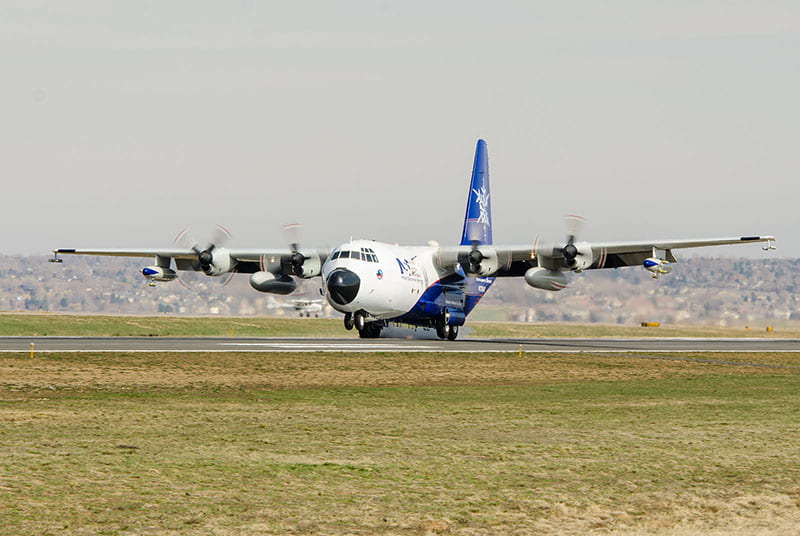
The Hercules C-130 aircraft, owned by NSF, will be used for GOTHAAM. Photo credit: The University Corporation for Atmospheric Research
The second project, titled “Collaborative Research: Greater New York Oxidant, Trace Gas, Halogen, and Aerosol Airborne Mission,” or GOTHAAM, effective September 1, 2020, also runs through August 2024 and totals nearly $3.5 million.
Led by John Mak, a professor in SoMAS, along with several co-principal investigators at Stony Brook University, and at six other universities around the country, GOTHAAM will assess the air quality, chemistry and pollutants in one of the most densely populated regions of the country, using the NSF’s C-130 aircraft. The greater NYC region is home to 20 million inhabitants, yet has a chemically diverse and complex atmosphere due to urban emissions, and emissions from coastal waters and inland forests. When that air is sunlit, the result is a chemically complex “soup” of primary emissions of reactive gases and aerosols, and their reaction products, some of which are toxic to humans, particularly with respect to the human respiratory system.
The GOTHAAM team will use air flights with measurements of the atmosphere’s composition to determine the biogenic, fossil fuel and aerosol compositions in the region. They will also evaluate various atmospheric oxidants and how nighttime chemical processes influence air mass composition. From the unprecedented observations, they will have a unique opportunity to test their understanding of air pollution above urban centers, and using computer simulations, test approaches for reducing the harmful components in “urban smog.”
For more information about this project, the plane used and additional details about what the grant funds, see this story.
Both Shepson and Mak are experienced pilots, and they will draw on those experiences in flight planning for the projects.
Additional Press:
NSF: Researchers set to take to the air above the Arctic and New York City
Newsday: Stony Brook professors to lead expeditions measuring air pollution
InnovateLI: With A Wing And A Grant, SBU Researchers Set To Soar
SBU receives NSF grant to study, engage others on regional air pollution
Photo above: The C-130 aircraft in flight. Nearly 100 feet (30 meters) long with a 132-foot (30-meter) wingspan, the C-130 carries a variety of instruments providing measurements important to atmospheric chemistry, dynamics, radiation, cloud physics and oceanography. It is used for atmospheric studies conducted around the world. Photo used with permission from the University of Colorado University Corporation for Atmospheric Research.
Stony Brook University researchers will lead a team of scientists from around the country to study air pollution and the chemical processes in the atmosphere that create or transform pollutants, such as ozone and particulate matter, in the New York City metropolitan area.
Over the course of the three-year study, funded with a $3.5 million grant from the National Science Foundation, scientists will fly a Hercules C-130 research aircraft for approximately 120 hours, spanning night and day. During the project, named GOTHAAM, for Greater NY Oxidant, Trace gas, Halogen, and Aerosol Airborne Mission, the researchers will measure different chemicals and pollutants in the air over the 300-mile metro area, encompassing New York City, Long Island, and parts of upstate New York and Connecticut.
“New York City, for the United States, is going to represent some of the most complex conditions not just because of the geographic component, with the interplay of marine, forests and urban environments, but also because we have the highest population density,” said John Mak, Professor in Stony Brook’s School of Marine and Atmospheric Sciences, who is the study’s lead principal investigator. “The biggest reason I wanted to do this study here was the number of people that it impacts. The population density is the highest in the nation and the magnitude of the emissions means you’re going to have really interesting large-scale chemical processes that are occurring and are impacting human health.”
Despite significant efforts to reduce air pollution in the NY region, the metro area has among the worst air quality in the country, second only to California. In this study, researchers seek to understand how chemical processes, and the interplay of human, marine and other natural elements combine to alter the composition and mix of pollutants in our air.
As interesting as the measurements will be for the team of scientists, Mak says they have far broader interests in the work, in addition to the academic enterprise. Even before they begin flying the aircraft – scheduled for the summer of 2022 – the team will reach out to local officials, residents, and politicians. They are eager, they say, to work with the community because they want their measurements to result in action that will lead to improvements in regional air quality.
“We want to apply our observations and analyses to improve current environment conditions,” Mak said. “I think the political awareness in both New York State and NYC gives us an advantage because leaders at state and local levels have been very much interested in air quality and reducing greenhouse gas emissions.”
In a partnership with Stony Brook’s Alda Center for Communicating Science, the team of researchers will participate in science communication training programs that will help them build trust among members of the community, including politicians and policymakers, and invite them to engage with the science and the research. They will bring high school students into the work through SBU’s School of Atmospheric and Marine Science’s summer Collegiate Science and Technology Entry Program, designed to bring minority students from high-needs districts to Stony Brook to explore science. They will host at least one open house, to invite community members to explore the plane and learn about aerial pollution monitoring projects.
“Across the world, we see significant impacts on public health because of air pollution – increased rates of asthma, heart and lung diseases, cancers and stroke,” said Laura Lindenfeld, Dean of the School of Journalism, Executive Director of the Alda Center, and Vice Provost for Academic Strategy and Planning. “Engaging people from all backgrounds in science can help our society make good policies and informed decisions in general. Inviting them to explore this project, and others like it, is critical to inspiring action to adapt and combat climate change.”
Lindenfeld is one of the co-principal investigators on the project. The others at Stony Brook are Paul Shepson, Dean of the School of Marine and Atmospheric Sciences, and Daniel Knopf, a Professor at SoMAS. Led by Stony Brook, the project is a collaboration between the School of Marine and Atmospheric Sciences and Alda Center for Communicating Science and researchers at University of Maryland, Baltimore County; University of Colorado; Colorado State University; University of Wisconsin, Madison; University of Michigan and University of California, Irvine.
While the plane is in the air, researchers will use dozens of specialized instruments – including some that have rarely been used before – to take as many measurements of the different compounds and air conditions as possible. With all the data, they should be able to determine patterns and expand their understanding of how chemicals interact with the different environments and weather conditions to create different types of compounds, including smog and other particulate matter, ozone, and harmful volatile organic compounds, which are all components of photochemical smog.
“We’re trying to make as many relevant measurements as we can so we can apply them to different situations of weather and season,” said Mak. “At the end of the day, we will be able to understand the evolution of these compounds and develop predictive models. So if the question, for example, is how much photochemical smog can be traced back to what trees emit, we should be able to answer that question. If we can answer those questions, that helps us understand how air quality and atmospheric chemical processes can be impacted by what we do, by human activities.”
SoMAS Expertise On Display During Shark Week
Lisa Crawford and members of the Frisk Lab join Oyster Bay Town Supervisor Joseph Saladino at Tobay Beach. Photos by Meredith Whitten.
The Lab of Dr. Michael Frisk attended a press conference in front of media on Wednesday August 12 in light of recent shark sightings on beaches of Long Island. The group presented their research and tracking efforts to the public to highlight how the work being completed at Stony Brook University is used monitor efforts to keep our local ecosystems healthy.
Dr. Michael Frisk, technician Michael Fogg, Ph.D. student Lisa Crawford, and Dr. Oliver Shipley joined Oyster Bay Town Supervisor Joseph Saladino at Tobay Beach.
Michael Fogg demonstrated how the lab uses acoustical tags attached to sharks to monitor the traffic in our local waters. Lisa Crawford, Dr. Shipley and Dr. Frisk pointed out that there is limited evidence for increased shark sightings and discussed long-term acoustic tracking of shark and other fish species. They further explained the importance of Long Island ecosystems as critical habitats for sharks, supporting a diverse array of species during the summer months in addition to outlining how chemical tracer techniques are being used to monitor shark feeding and health. Results from long-term tracking in the New York Bight acoustic network and the recently installed acoustic gate to Great South Bay funded by NYSDEC were highlighted.
The press conference was covered by several news agencies:
CBS New York Shark Patrols Increase At Long Island Beaches After Spike In Sightings
Fox 5 NY After series of recent shark sightings, new safety measures in place on Long Island beaches
ABC 7 NY With 20 sharks spotted in 2 weeks, tracking efforts underway on Long Island
News 12 Long Island Stony Brook researchers explain efforts to monitor local marine life amid repeated shark sightings
Pix11 Researchers say Long Island shark sightings are normal for this time of year
SoMAS Faculty Unfolding the Secrets of Ice Formation to Better Understand Climate
From Unfolding the Secrets of Ice Formation to Better Understand Climate on Stony Brook University News, August 8, 2020.
STONY BROOK, NY, August 7, 2020 – Ice crystal formation plays a crucial role in precipitation formation and alters the radiative properties of clouds, thereby affecting Earth’s climate system. In recent years there has been tremendous progress in understanding how liquid-phase droplets are formed (nucleation), yet the nucleation of ice crystals has remained elusive. That’s why Daniel Knopf, PhD, Professor in the School of Marine and Atmospheric Sciences (SoMAS) at Stony Brook University, is studying the nucleation of ice crystals with the goal to improve current cloud and climate modeling approaches. The research is supported by a three-year $710,000 grant from the Department of Energy that starts September 15, 2020.
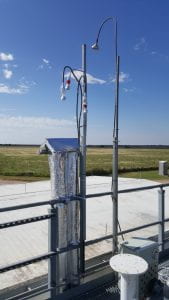
An aerosol sampling stack and inlet tubes at the DOE’s Atmospheric Radiation Measurement Program Site in Oklahoma for studying ice formation from aerosol particles.
“Ice formation is considered one of the remaining grand challenges in the atmospheric sciences,” says Professor Knopf. “The objective of the project is to gain a predictive understanding of the chain that leads from aerosols to ice-nucleating particles to ice crystal number concentrations in clouds.”
He hopes the results of the project will guide concrete improvements in the current cloud and climate modeling approaches to ice formation by advancing understanding of the coupling between detailed aerosol physicochemical properties and in-cloud ice crystal number concentrations. This understanding would ultimately result in better predictions of the climatic impact of ice crystal containing clouds.
The grant (DE-SC0021034) is part of a group of national awards under the DOE’s Atmospheric System Research program.
SoMAS Study Projects More Intense Rain During Future Hurricanes
Photo Above: A visible image of Tropical Storm Cristobal on June 5 over the Gulf of Mexico and surrounding areas. New research suggests future storms that make landfall over eastern U.S. coasts may carry more intense rain totals per hour (credit: NASA Worldview)
From Study Projects More Intense Rain During Future Hurricanes at the Stony Brook University News, June 15, 2020.
The News in Brief:
- Using climate change projection simulations, researchers predict that North Atlantic hurricane frequency decreases but median intensity increases in the future.
- Simulations show higher precipitation rates per storm and increased amounts of precipitation per hour, potentially causing dangerous impact.
- Due to fewer hurricanes hitting land in the U.S., overall rainfall amounts from tropical storms will decrease.
STONY BROOK, NY, June 15, 2020 – By using global climate modeling, a team of researchers at the School of Marine and Atmospheric Sciences (SoMAS) at Stony Brook University project that future tropical cyclones, or hurricanes, will feature more intense rain with more rain produced per hour than previous storms. To be published in Geophysical Research Letters, the study suggests that while rain intensity is likely to increase the number of storms that make landfall in the United States will decrease.
Landfalling hurricanes create dangerous conditions for U.S. residents in eastern coastal states through heavy rainfall, strong winds, and storm surge. The prospects of storms that carry intense rain patterns over short periods of time would increase levels of danger for the entire region because of flooding and storm surge.
“Essentially our work with climate and storm modeling provides evidence that hurricanes will produce more precipitation per hour of impact in the future,” said Kevin Reed, Ph.D., Associate Professor in SoMAS. “This finding is consistent and adds to our work using models of Hurricane Florence and tracking extreme amounts of rainfall,” he added, referring to a study published earlier this year in Science Advances and explained in this news release.
The researchers used a global climate model that is called a variable-resolution version of the Community Atmospheric Model 5 (CAM5), a model utilized to study North Atlantic tropical cyclone climatology in the context of climate change. They ran CAM5 simulations to study changes in storms’ intensities, sizes, and rainfall accumulations.
Overall they discovered from the simulations of future storms that the number of hurricanes in the North Atlantic decreases and so does the number of hurricanes that would make landfall on the U.S. However, the simulations indicated that the average intensities of these storm increase and the amount of total rainfall per storm also increases. Yet total rainfall from fewer storms may decrease in the future.

This visual shows the annual average storm-related extreme rainfall per hour over eastern U.S. coastal areas. Red is indicative of the most extreme rain fall per hour. At left is the historical record of storms. Projected scenarios using climate change storm modeling are intermediate (center) and worst-case predictions (right).
Reed explains that climate change will likely play a role in future storms and could certainly cause changes in rain intensity and totals based on modeling.
Alyssa Stansfield, a SoMAS student, PhD candidate, and lead author of the paper, whose graduate work centers on understanding how hurricanes will be different in the future because of climate change, adds that “predicting how rainfall from hurricanes will be impacted is especially important because flooding is a very dangerous hazard associated with hurricane landfalls.”
The storm modeling work is a part of continuing research to quantify how tropical cyclone-induced hazards may change in future climates. The research is supported in part by the Department of Energy’s Office of Science.
###
Stansfield, A. M., Reed, K. A., & Zarzycki, C. M. (2020). Changes in Precipitation from North Atlantic Tropical Cyclones under RCP Scenarios in the Variable‐Resolution Community Atmosphere Model. Geophysical Research Letters, e2019GL086930.
Additional Media
SoMAS Research part of 180 Covid-19 Studies Launched at SBU Since Start of Pandemic
From More than 180 Covid-19 Studies Launched at Stony Brook Since Start of Pandemic on Stony Brook University News, May 28, 2020
Investigations involve faculty from 45 academic departments and eight schools
STONY BROOK, NY, May 28, 2020 – In just the two plus months since Governor Cuomo declared a State of Emergency because of the Covid-19 pandemic, Stony Brook University researchers have launched more than 180 Covid-19 related studies in order to battle the virus and examine circumstances where it has or will change our societal landscape. The body of work spans 45 academic departments from eight different colleges and schools within the University. The research not only includes investigating prevention and treatment of the virus but also focuses on topics such as the psychological impacts of social distancing measures, tracking levels of community distress, and examining the impact of the pandemic on students.
“It is the responsibility of a research-intense academic medical center, such as Stony Brook Medicine, to not only provide outstanding care for patients afflicted with Covid-19, but also to mine all the clinical data, generate hypotheses helping to explain the interaction of virus and host, understand the pathophysiology of the various manifestations of the disease, and explore novel approaches to the best possible treatment for the disease,” said Kenneth Kaushansky, MD, Dean of the Renaissance School of Medicine and Senior Vice President for Health Sciences.
“The overwhelming response from our researchers in this time of need shows the breadth of Stony Brook’s expertise, which spans healthcare, physical and social sciences and many other academic disciplines,” said Richard J. Reeder, Vice President of Research at Stony Brook University. “Their innovative work during this crisis will help to solve many of the challenges we face now and in the future because of Covid-19.”
Researchers have started 52 clinical trials centered on prevention, treatment and care of patients with Covid-19, all in the effort to fight the disease now. Other research involves the collaborative work of scientists and faculty looking toward the near future and long-term on the effects of the pandemic.
The following are summaries and examples of some of research taking place within each school and collaboratively:
School of Marine and Atmospheric Sciences
The New York State Center for Clean Water Technology has begun monitoring of nCoV in sewage to provide data to assess temporal dynamics in outbreaks of COVID-19 in communities. Because viral load in sewage can pre-date symptoms, it is a potential leading indicator of infection which communities could be targeted for heightened intervention. The Center is collecting samples of sewage from multiple Long Island communities to track densities of the nCOV. According to Dr. Chris Gobler, “this approach has the potential to identify second waves of infections emerging in communities before patients begin to show up and overwhelm hospitals.” The goal is to develop a system for pathogen detection that can serve as an early warning system for any “Second Wave” of nCoV before people are getting sick.
Dr. Daniel Knopf is using instrumentation at the SoMAS’ Aerosol Research Laboratory to assist medical colleagues in the Renaissance School of Medicine in the performance evaluation of N95 masks that have been heat treated for sterilization purposes.
Renaissance School of Medicine
Seventy-five studies have been launched by researchers across 20 different departments. These topics range from examining the impact of convalescent plasma on COVID-19 complications, whether dry heat can disinfect N95 masks, using Artificial Intelligence to detect COVID-19 and predict outcomes, assessing physician mental health during the pandemic, use of estrogen as a treatment for COVID-19, assessing the effectiveness of telemedicine, establishment of a biobank for COVID-19 patient samples, and the development of antibody tests.
College of Arts and Sciences / School of Medicine
Researchers have formed collaborations on two different Covid-19 related research studies. One study focuses on exchanging lipids in the viral coat, and another study is examining SARS-CoV2 proteins in plants for scaled-up production of antigens.
College of Arts and Sciences
More than 40 studies are underway by researchers across 10 disciplines, and over half of these are in the Department of Psychology. Topics include the impact of social isolation on well-being; keeping the economy afloat while waiting for a vaccine; and a study that expands on a currently funded National Science Foundation Alliances for Graduate Education and the Professoriate (AGEP) program to examine trainee experiences with online teaching and learning.
College of Engineering and Applied Sciences / School of Medicine
Leveraging the strong research relationship between the College and School of Medicine, researchers are currently conducting 10 Covid-19 related studies. Studies include investigating Artificial Intelligence to aid in the drug discovery of antiviral candidates against Covid-19, the effects of the virus on coagulation, developing informatics solutions for high throughput analysis of Covid-19 imaging, and longitudinal biomonitoring for frontline healthcare providers.
College of Engineering and Applied Sciences
Researchers from four different departments have launched six studies. These studies focus on topics including decision support for cancer treatment during the COVID pandemic, tracking levels of community distress, vaccine design for unknown targets, and creating a diagnostic tool for rapid Covid-19 infection detection.
School of Social Welfare
More than 20 studies have been launched by researchers in the School of Social Welfare. The studies focus on several different topics including, the impact of social distancing on mental health and substance abuse, the impact of isolation on older adults during the Covid-19 crisis, the impact of the crisis on first-generation college students, and an examination of family violence during it.
School of Health Technology and Management
Research includes a study examining the impact of COVID-19 on occupational participation and satisfaction with life.
School of Nursing
A team of researchers is examining the effect of the pandemic on student nurses involved in the response of the Covid-19 crisis.
College of Business
A research study examining the impact of the socioeconomic status in the context of Covid-19 related decisions is one study underway in the College.
Additional information on specific research taking place in any of the schools can be provided, and faculty are available to discuss their research projects and why they are relevant to the Covid-19 crisis and the pending aftermath.
SoMAS Researchers: Dissolved Oxygen and pH Policy Leave Fisheries at Risk
Photo above: Stony Brook’s Christopher Gobler is one of Long Island’s leading experts on water conservation.
From Researchers: Dissolved Oxygen and pH Policy Leave Fisheries at Risk on Stony Brook University News, April 23, 2020
Stony Brook University’s Christopher J. Gobler, Endowed Chair of Coastal Ecology and Conservation, and Stephen J. Tomasetti, Science Teaching and Research to Inform Decisions (STRIDE) fellow, consider accumulating scientific evidence on the harmful effects of coastal hypoxia (low oxygen) and acidification (decreasing pH, increasing acidity) in coastal ecosystems in the April 24 issue of the journal Science.
In a Policy Forum, “Dissolved oxygen and pH criteria leave fisheries at risk” the scientists suggest approaches that would address current policy shortfalls and facilitate improved protection of aquatic life.
During the past two decades, scientists have learned how hypoxia and acidification can act and interact to harm marine organisms. Hundreds of low oxygen or dead zones have been identified across the globe. Ocean acidification, a process resulting from the continued buildup of increasing atmospheric carbon dioxide in the oceans, has been discovered. And yet, regulation of dissolved oxygen (DO) and pH in coastal waters have remained unchanged.
The Clean Water Act aims to restore and protect the waters of the United States from impairment; waters that do not meet state standards are listed as impaired, a designation that can initiate critical remediation actions. According to Dr. Gobler, the current saltwater DO and pH criteria of many states allow for harmful conditions to persist without amelioration. “Our understanding of the dynamics of DO and pH and the effects on marine life have advanced dramatically this century to the point that it is now clear that criteria for pH and DO are likely to leave important marine species vulnerable to harm”, he said.
The reduction of DO and pH in coastal waters can individually have adverse effects on aquatic life, however, current regulations do not consider the combined effects of these stressors which are often experienced in combination and can be more severe than each stressor individually. Not until the scientific field of Ocean Acidification had been established, had their combined effects been broadly considered.
SBU Researchers Collaborate on Genetic Tool Development in Marine Protists
Photo above: A set of Microscopic images of Aurantiochytrium cells. The top images show a wild-type Aurantiochytrium cell and the bottom images show a genetically engineered Aurantiochytrium cell that now expresses green fluorescent protein (GFP). The scale bar represents 10μm.
From SBU Researchers Among 100 Scientists Collaborating on Genetic Tool Development in Marine Protists on SBU News, April 7, 2020.
For the past several years, School of Marine and Atmospheric Sciences Associate Professor Jackie Collier and PhD candidate Mariana Rius, along with Associate Professor Joshua Rest from the College of Arts and Sciences Department of Ecology and Evolution, developed the tools and methodology for genetically transforming a single-celled marine fungus-like organism known as Aurantiochytrium limacinum ATCC MYA-1381. The three were among more than 100 scientists spanning 41 research groups across the globe who collaborated on the development of genetic tools in 39 evolutionarily diverse unicellular marine eukaryotes (protists).
Their paper, Genetic Tool Development in Marine Protists: Emerging Model Organisms for Experimental Cell Biology, appears in the April issue of Nature Methods and was referred to by one of the paper’s reviewers as “a great resource that will be used for years to come as an authoritative encyclopedia of genetic manipulation of protists.”
These genetic tools are the primary means in which an understudied and generally underappreciated marine microbe emerges into a model organism. Expanding the evolutionary as well as the ecological breadth of diverse eukaryotes that can undergo genetic modification creates the foundation for questions regarding eukaryotic cell biology, evolution, ecology, metabolism, reproduction, etc. to be addressed head on. These eukaryotes play an enormous role in the ocean’s biogeochemical cycling and are an integral component of marine food webs.
“It is through this kind of ‘risky’ work that our scope and understanding of what is actually happening in our oceans truly gets to expand,” Rius said. This exploratory and pioneering work is an example of “building a well-connected community to overcome technical challenges and accelerate the development of genetic tools.” (Faktorova et al., 2020).
The Gordon and Betty Moore Foundation’s Experimental Model Systems (EMS) Strategy extended far beyond financial support; EMS specific sessions and events at conferences, monthly webinars and a Protist Research to Optimize Tools in Genetics (PROT-G) community facilitated troubleshooting, brainstorming and implementing new ideas and approaches in overcoming the challenges ingrained in the very nature of these kinds of research advancements.
The Moore Foundation’s EMS investment to support scientists worldwide in the development of marine microbial experimental model systems has raised the bar in the sort of questions ecologists, cell biologists and researchers worldwide can ask when looking at the diversity of protists and the complexities of our oceans.
Three Stony Brook Researchers Among 100 Scientists Collaborating on Genetic Tool Development in Marine Protists
Experts call for immediate action to save the world’s most resilient corals
Photo Above: Corals in the Gulf of Aqaba (credit Ove Hoegh-Guldberg)
Despite political tensions between countries along the Red Sea, researchers band together to call upon UNESCO to declare the Red Sea’s entire coral reef as a Marine World Heritage Site while recommending additional measures critical for the reef’s survival
Rapid ocean warming due to climate change poses a serious risk to the survival of coral reefs. It is estimated that 70-90% of all reefs will be severely degraded by mid-century even if the 1.5◦C goal of the Paris Climate Agreement is achieved. There is one coral reef ecosystem, however, that seems more resilient to rising sea temperatures than most others. Corals in the Gulf of Aqaba, at the northernmost portion of the Red Sea, have an unusually high tolerance for the rapidly warming seawater in the region. They withstand water temperature irregularities that cause severe bleaching or mortality in most hard corals elsewhere. This uniquely resilient reef employs biological mechanisms which are likely to be important for coral survival as the planet’s oceans warm.
While the Gulf of Aqaba could potentially be one of the planet’s largest marine refuge from climate change, this unique portion of the Red Sea’s reef will only survive and flourish if serious regional environmental challenges are addressed. In a study just published in Frontiers in Marine Science, an international group of researchers outlines these challenges and proposes a number of necessary measures they say must be immediately implemented in order to protect the reef from increasing local threats.
The study was led by Dr. Karine Kleinhaus, of the Stony Brook University School of Marine and Atmospheric Sciences, and co-authored by Prof. Maoz Fine, of Bar-Ilan University’s Mina and Everard Goodman Faculty of Life Sciences, along with a group of scientists who have studied the Red Sea’s corals while based in Egypt, Israel, Jordan, Saudi Arabia, Australia, the United States and Switzerland. The Swiss Ambassador to Israel also contributed to the article. The collaboration of these co-authors, despite regional political tensions, underscores the importance of this call for action.
The coral reefs of the Red Sea provide food and a source of livelihood to a rapidly growing population of over 28 million people living along its coastline, and are a uniquely rich potential source of new medicines. However, as towns and cities continue to grow along the Red Sea, these areas generate substantial local pressure on its reefs. Some portions of the reef have already been heavily damaged by uncontrolled tourism, human population expansion, overfishing, and coastal development that has led to pollution and a decline in coastal water quality.
Despite existing environmental stressors and newly emerging threats, there are currently no coordinated scientific research or management efforts that encompass the entire Red Sea reef complex. The researchers assert that the most urgent objective is to advance immediate protection of the Gulf of Aqaba as a World Heritage Site as part of an initiative involving Egypt, Israel, Jordan, and Saudi Arabia. Ideally, they say scientists, conservationists, and policy makers should advocate strongly that UNESCO recognize the Red Sea’s entire coral reef as a Marine World Heritage Site. Regional scientists and governments should work together to implement transnational research, monitoring and conservation efforts and seek UN support for a long-term scientific monitoring program. Considering political realities, the authors affirm that regional collaboration can be effectively facilitated by the Transnational Red Sea Center, a neutral organization which was established in March 2019 and is based at the Swiss Ecole Polytechnique Fédérale de Lausanne (EPFL).
The researchers recommend several additional measures including:
- Full regional cooperation under the directive of high levels of government
- Informing governments of the monetary value and vast medicinal potential of the reef to each nation
- Long-term regional monitoring of the threat to the reefs from new coastal development and the accompanying population expansion
- Sustainable development of the Red Sea coastline
“Threats to the Red Sea’s reef in its entirety, and to the uniquely resilient northernmost segment, are escalating, and we will need to work together to preserve them despite the many political and practical challenges. Otherwise, we will have to explain to future generations that we stood by as our generation destroyed one of the last reefs standing,” the authors conclude.
Kleinhaus K, Al-Sawalmih A, Barshis DJ, Genin A, Grace LN, Hoegh-Guldberg O, Loya Y, Meibom A, Osman EO, Ruch J-D, Shaked Y, Voolstra CR, Zvuloni A and Fine M (2020). Science, Diplomacy, and the Red Sea’s Unique Coral Reef: It’s Time for Action. Front. Mar. Sci. 7:90. DOI: 10.3389/fmars.2020.00090
Substantial Natural History Collection Gifted to SoMAS
Photo above: the Research Vessel Seawolf conducting a cruise on the Hudson River.
From Extraordinary Collection of Marine Specimens and Data Donated to University on SBU News, December 6, 2019
Gift provides a windfall of unpublished biological and water quality data for 43 years of Hudson River sampling, including preserved specimens.
An extraordinary scientific collection of fish specimens, as well archived fish and water quality data taken from the Hudson River over more than five decades, has been donated to Stony Brook’s School of Marine and Atmospheric Sciences (SoMAS).
What is now known as the Hudson River Collection (the Collection), donated to the university by the integrated energy company, Entergy Corporation (Entergy), began in the 1960’s as “one of the most ambitious environmental research and assessment programs ever performed” on an iconic River that was a focal point for the nascent U.S. environmental movement. As it grew, the Collection became unique, variously referred to as “probably the best dataset on the planet,” “unequalled globally in its duration and its spatiotemporal frequency” and “extraordinarily important, because it provides a retrospective and unbroken view of the ecological health of the estuary over time.”
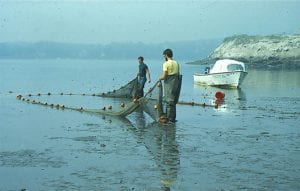
The Long River Beach Seine survey, begun in 1974, is among many unique scientific samplings represented in the Hudson River Collection.
The Collection includes Indian Point-sponsored, digitized survey data for the full complement of fish species (approximately 170) available to the sampling gear in the approximately 150-mile Hudson River Estuary (from the Battery to the Troy Dam), and the associated water quality and Indian Point-specific biological information. The Collection also includes the associated archived fish specimens, consisting mostly of preserved early life stages of Estuarine fish, numbering approximately 50 million individuals. The database is unequalled, and the specimens from the Collection represent among the largest held by any U.S. museum or university, placing Stony Brook among a handful of renowned institutions, such as the Smithsonian.
Entergy also has made a substantial donation of seed capital to advance Stony Brook’s goal of groundbreaking scientific study related to the Collection – study that dovetails with SoMAS’s expertise on coastal, marine, estuarine ecosystems, including biodiversity, population genetics, climate change and disease. The Collection’s digitized databases make them readily usable “big data,” susceptible to the cutting-edge statistical methods and advanced computing on which Stony Brook excels.
“This donation positions Stony Brook as a leader in developing innovative forms of multidisciplinary science endeavors,” said Michael A. Bernstein, Interim President of Stony Brook University. “I am confident that our unparalleled access to the Hudson River Collection will result in extraordinary research opportunities.”
“We want to thank the New York State Department of Environmental Conservation and leading scientists for supporting us in our search for the right home for the Collection,” said Mike Twomey, Senior Vice President, Federal Policy, Regulatory and Government Affairs for Entergy. “SoMAS and Stony Brook are the right home for an unparalleled Collection, one that we could not be more pleased to give.”
Paul Shepson, Dean of SoMAS, echoed those thanks, underscoring that the Collection will not only advance SoMAS’s standing as a leading research and educational institution, but enable scientists and their students to better understand a wide range of subjects, beginning with the environmental drivers within the Hudson River ecosystem and aquatic ecosystems in general.
“The Collection’s data and samples will enable leading scientists to develop collaborative and interdisciplinary research projects, leading to new discoveries that will be instrumental in understanding changes in estuarine and marine environments both locally and worldwide,” said Shepson. “We are both excited and grateful to Entergy for entrusting Stony Brook with such an incredible and unprecedented collection.”
###
About Stony Brook University
Stony Brook University, widely regarded as a SUNY flagship, is going beyond the expectations of what today’s public universities can accomplish. Since its founding in 1957, this young university has grown to become one of only four University Center campuses in the State University of New York (SUNY) system with over 26,000 students, more than 2,700 faculty members and 18 NCAA Division I athletic programs. Our faculty have earned numerous prestigious awards, including the Nobel Prize, Pulitzer Prize, Indianapolis Prize for animal conservation, Abel Prize and the inaugural Breakthrough Prize in Mathematics. The University offers students an elite education with an outstanding return on investment: U.S. News & World Report ranks Stony Brook among the top 40 public universities in the nation. Its membership in the Association of American Universities (AAU) places Stony Brook among the top 62 research institutions in North America. As part of the management team of Brookhaven National Laboratory, the University joins a prestigious group of universities that have a role in running federal R&D labs. Stony Brook University fuels Long island’s economic growth. Its impact on the Long Island economy amounts to $7.38 billion in increased output. Our state, country and world demand ambitious ideas, imaginative solutions and exceptional leadership to forge a better future for all. The students, alumni, researchers and faculty of Stony Brook University are prepared to meet this challenge.
About SoMAS
SoMAS is the State University of New York’s designated center for marine sciences and a leader in marine, atmospheric and sustainability research, education, and public service. Currently, there are more than 500 undergraduate and graduate students and 90 faculty and staff from 16 different nations working together to better understand how our marine, terrestrial, and atmospheric environments function, are related to one another and how they and their associated living resources may be sustained for future generations. Research at SoMAS explores solutions to a variety of issues facing the world today ranging from local problems affecting the area around Long Island to processes that are impacting the entire globe.
About Entergy Corporation
Entergy Corporation (NYSE: ETR) is an integrated energy company engaged primarily in electric power production and retail distribution operations. Entergy owns and operates power plants with approximately 30,000 megawatts of electric generating capacity, including 9,000 megawatts of nuclear power. Entergy delivers electricity to 2.9 million utility customers in Arkansas, Louisiana, Mississippi, and Texas. Entergy has annual revenues of $11 billion and approximately 13,500 employees. Additional information is available at entergy.com.
NY Sea Grant Contributes to Marine Aquaculture Research Projects
Photo above: SBU’s Bassem Allam is the lead PI on a study of hard clams (photo by Bassem Allam); Inset photo: A worker at Norm Bloom & Son Oysters offloads shellfish harvested from the company’s beds in Norwalk, CT (photo by Judy Benson, Connecticut Sea Grant).
From NY Sea Grant Contributes to Marine Aquaculture Research Projects on Stony Brook News, November 14, 2019
Two important aquaculture studies on New York’s marine waters will be administered at Stony Brook University through New York Sea Grant (NYSG). These projects are part of a national suite of 42 research projects and collaborative programs supported by $16 million in federal funding by the National Oceanic and Atmospheric Administration (NOAA) to advance sustainable aquaculture in the United States.
“Aquaculture as a source of sustainable food, healthy habitat and clean water, and economic opportunity has gained considerable, and growing, national and global attention in the past several years. However, there is still much to learn. New York Sea Grant is pleased to be able to participate with diverse partners on a suite of grants supporting collaborative research aimed at understanding and informing the potential of shellfish, finfish, and seaweed aquaculture across the state,” said NYSG Director Dr. Rebecca Shuford.
NYSG’s contribution to aquaculture research supports three areas of need identified by the National Sea Grant Office federal funding opportunities. These areas include accelerating the development of aquaculture in established topics, exploring new opportunities, as well as addressing gaps in social, behavioral, and economic research relating to US aquaculture.
New York Sea Grant (NYSG), a cooperative program of Cornell University and the State University of New York (SUNY), is one of 33 university-based programs under the National Oceanic and Atmospheric Administration’s National Sea Grant College Program.
More About the Projects
East Coast Hard Clam Selective Breeding Collaborative Project
This project — a $1.2 million collaborative effort with NYSG and Stony Brook University along with Cornell University, Rutgers University and the Virginia Institute of Marine Sciences — will apply selective breeding to improve the resilience of hard clam stocks cultured across the Atlantic seaboard. Bassem Allam, Marinetics Endowed Professor at the School of Marine and Atmospheric Sciences at Stony Brook University is lead PI on this project, which also includes shellfish biologists and geneticists, Sea Grant and Cornell Cooperative Extension specialists, and industry partners located in five states (Florida, Massachusetts, New Jersey, New York and Virginia) where there is significant hard clam aquaculture.
Nurturing Successful Growth and Maturation of a Domestic Seaweed Aquaculture Industry: Identifying and Removing Barriers and Promoting Opportunities
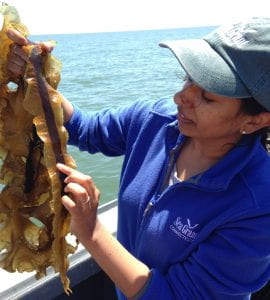
Connecticut Sea Grant Aquaculture Specialist Anoushka Concepcion the PI on a new National Sea Grant Seaweed Hub (photo by Tessa Getchis).
The second NYSG project is a nearly $1.1 million collaborative effort led by Connecticut Sea Grant, partnering with the National Sea Grant Law Center and various other Sea Grant programs to establish a National Sea Grant Seaweed Hub that will serve as a central clearinghouse for science-based, non-proprietary resources related to previous and current seaweed aquaculture research and extension efforts.
Other Projects
In addition to federal funding awarded to the East Coast marine research projects, NYSG is also part of a three-year, $1 million multi-state Great Lakes Aquaculture Collaborative project designed to help Great Lakes States respond to consumer demand for freshwater fish and address the $14 billion national seafood trade deficit identified by the NOAA National Marine Fisheries Service.
For more information on the 42 research projects and collaborative programs supported, see the National Sea Grant College Program announcement.
Additional Coverage:



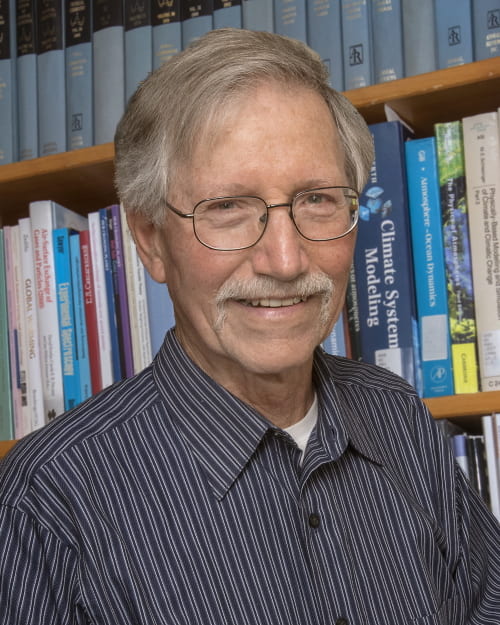


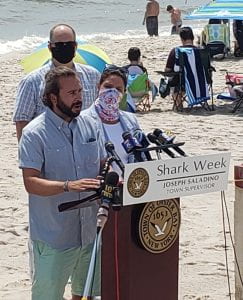



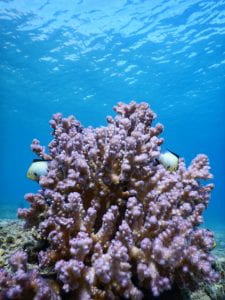
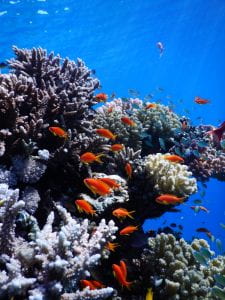
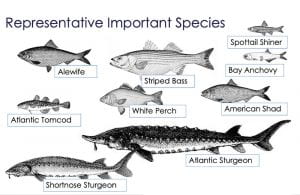
You must be logged in to post a comment.